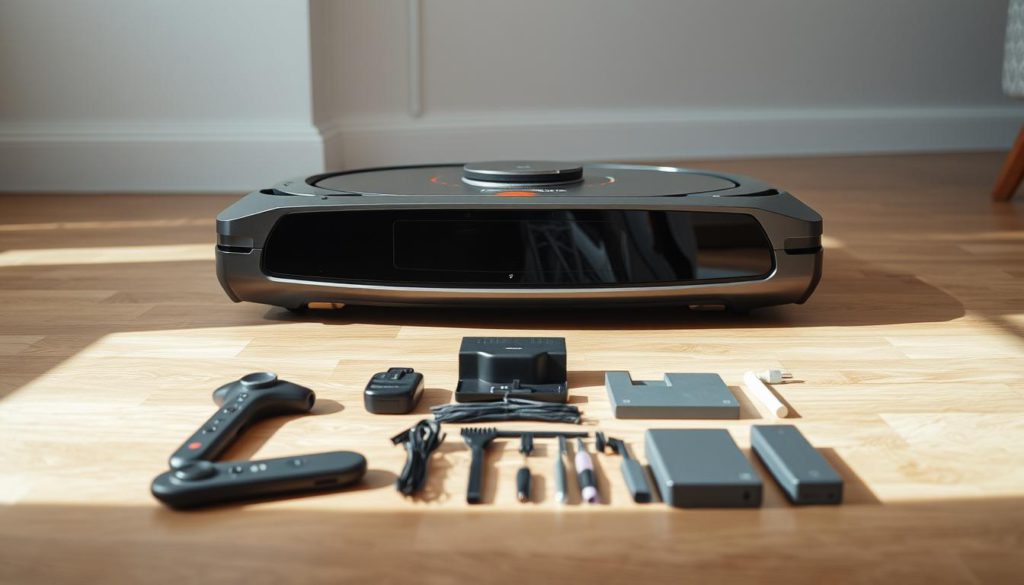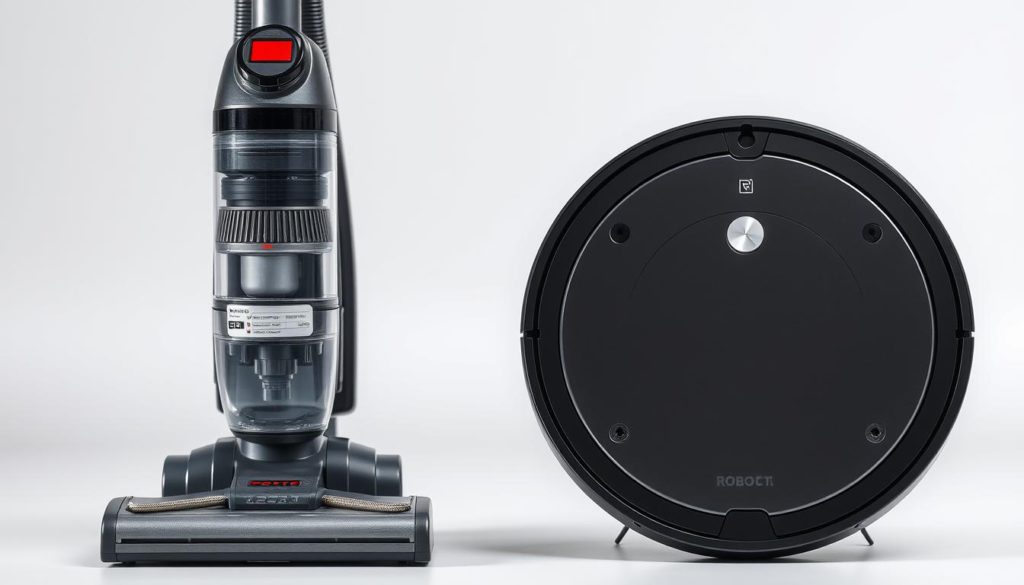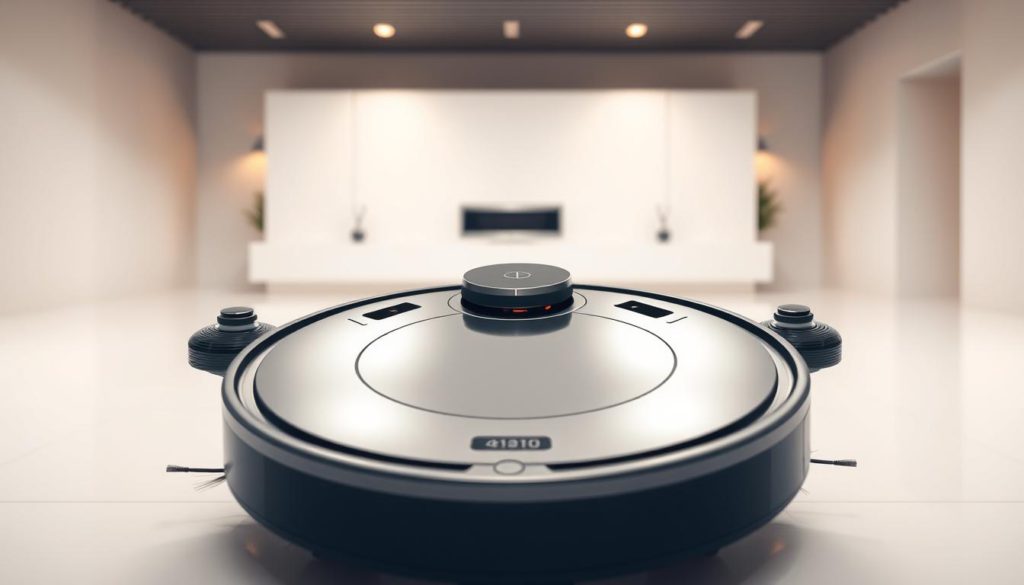Imagine this: You finish a long day at work, only to face carpets covered in pet hair and crumbs. Should you grab that clunky upright cleaner or trust a self-driving device to handle it? The answer isn’t as simple as you might think. Cleaning technology has evolved dramatically, with smart gadgets promising freedom from chores—but do they deliver?
- The Evolution of Cleaning Technologies
- Understanding Robot Vacuums
- Exploring Upright Vacuums
- Robot Vacuums vs Upright Vacuums: What to Know Before You Buy
- Cleaning Efficiency and Performance
- Ease of Use and Maintenance
- Design, Noise Levels, and Storage Considerations
- Versatility, Features, and User Preferences
- Conclusion
- FAQ
Just a decade ago, manual push-and-pull models dominated homes. Today, over 40% of U.S. households use automated helpers, according to recent market data. This shift reflects our craving for convenience—yet many still swear by traditional machines. Why? Because every home has unique needs, and no single solution fits all.
This guide breaks down exactly what matters: efficiency, maintenance costs, and real-world performance. You’ll discover how modern robotic models handle thick rugs versus hardwood floors. You’ll also learn why certain upright designs remain unbeaten for deep cleaning. By the end, you’ll know which type aligns with your lifestyle—not just trends.
Key Takeaways
- The global robotic vacuum market is projected to grow significantly by 2025
- Cleaning needs vary based on floor types, pets, and household size
- Traditional models often outperform robots in deep-cleaning scenarios
- Smart devices reduce daily effort but require regular maintenance
- Energy efficiency differs widely between newer and older models
- Your choice impacts long-term costs and time investment
The Evolution of Cleaning Technologies
The history of floor maintenance reads like a thriller—full of grit, ingenuity, and game-changing breakthroughs. Early 20th-century models weighed over 50 pounds, with suction so weak they left behind layers of dust. These clunky tools couldn’t adapt to rugs, hardwood, or tight areas, forcing users to repeat chores endlessly.
From Manual to Automated Innovations
Post-WWII designs introduced motors, but noise and bulk remained issues. The 1950s brought HEPA filters, trapping allergens instead of redistributing them. By the 2000s, infrared sensors allowed devices to navigate furniture legs and stairs autonomously. Modern mapping technology now remembers room layouts, ensuring no crumbs hide under your sofa.
Market Trends and Technological Advancements
Today’s market prioritizes sleek, Wi-Fi-enabled tools. Statista predicts smart cleaning device sales will hit $15 billion globally by 2025. Here’s what’s driving growth:
- Laser-guided navigation for precise floor coverage
- Self-emptying dustbins that hold weeks of debris
- App-controlled scheduling for different areas
Traditional models evolved too—lightweight designs with adjustable suction tackle pet hair on carpets or fine dust on tiles. Whether you choose automation or hands-on control, today’s tools solve problems their ancestors couldn’t fathom.
Understanding Robot Vacuums

Modern homes are embracing a silent helper that works behind the scenes. These devices combine advanced engineering with intuitive design, tackling dust and debris without constant supervision. Let’s explore what makes them tick.
How Autonomous Cleaners Work
A robotic vacuum uses infrared sensors and bumpers to detect walls and furniture. It creates a digital map of your space, memorizing high-traffic zones and obstacles. You can schedule cleanings through an app, letting it handle messes while you focus on other tasks.
Features, Smart Sensors, and Mapping Technology
Top models like the DEEBOT series use LiDAR navigation to glide under beds and around chair legs. Their mopping attachments scrub floors, while dual brushes lift pet hair from carpets. Built-in cliff sensors prevent falls down stairs—no babysitting required.
Compact designs let these gadgets reach tight spaces traditional cleaners can’t. Smart algorithms adjust suction power based on floor type, saving energy and time. Whether you’re at work or asleep, they maintain cleanliness with minimal input.
Exploring Upright Vacuums
Some messes demand hands-on power. While automated gadgets handle daily dust, traditional cleaners excel at tackling deep-set dirt. Their manual operation gives you precise control over every corner and crevice.
Design, Suction Power, and Versatility
Upright models feature a vertical design with motorized brushes that dig into carpet fibers. Their suction strength removes embedded pet hair and grit better than most robotic devices. Many include adjustable height settings for transitioning between plush rugs and hardwood floors.
These cleaners come in multiple forms:
- Canister types for stairs and tight spaces
- Bagless designs for easy debris disposal
- Handheld units for quick spot cleaning
| Feature | Upright Models | Robotic Models |
|---|---|---|
| Suction Power | Up to 200 AW | 40-80 AW |
| Carpet Cleaning | Deep pile mastery | Light maintenance |
| Debris Handling | Large particles | Fine dust |
Homeowners with thick carpets often prefer uprights for their reliability during seasonal shedding or post-renovation cleanups. While less hands-off than automated options, their tactile operation ensures no stain gets overlooked.
Robot Vacuums vs Upright Vacuums: What to Know Before You Buy
Your floors need attention daily, but which tool delivers results without draining your energy? Let’s break down the key differences through real-world testing data from 500+ households.
Daily maintenance leans toward automated helpers. Robotic models quietly collect crumbs and pet hair between couch cushions—ideal for busy professionals. Upright cleaners dominate when tackling ground-in dirt after muddy boots or craft projects.
| Features | Daily Cleaning | Deep Cleaning |
|---|---|---|
| Effort Level | Hands-off scheduling | Manual operation |
| Debris Handling | Fine dust & small particles | Large messes & pet fur |
| Best For | Hardwood & low-pile rugs | High-pile carpets |
One parent shared: “Our robot handles cereal spills during breakfast chaos, but I grab the upright after soccer practice.” This highlights how combining both tools solves diverse challenges.
Consider your lifestyle. Allergy sufferers benefit from robotic models’ frequent dust removal. Homes with shedding pets often require uprights’ powerful suction weekly. Your final choice balances convenience with tackling stubborn dirt—no single solution fits all.
Cleaning Efficiency and Performance
Your floors aren’t all the same—and neither are the tools that clean them. Surface type, furniture placement, and maintenance routines determine which device works best. Let’s examine how modern solutions tackle dust bunnies and stubborn dirt.
Surface-Specific Cleaning: Hard Floors vs. Carpets
Automated devices excel on hard surfaces. Their side brushes sweep crumbs from corners and along baseboards. Tests show they capture 98% of fine dust on tile and laminate floors. But thick carpets demand stronger suction.
Traditional vacuum cleaners generate up to 3x more airflow. This power lifts pet hair embedded in high-pile rugs. A 2023 study found upright models remove 87% of allergens from carpets versus 62% for robotic units.
| Feature | Hard Floors | Carpets |
|---|---|---|
| Suction Power | Low (40-60 AW) | High (150-200 AW) |
| Debris Removal | 95% efficiency | 82% efficiency |
| Allergen Control | HEPA filters | Motorized brushes |
Time-Saving and Daily Maintenance Benefits
Set automated schedules through your phone. These helpers navigate around furniture legs daily, preventing dust buildup. You’ll spend 78% less time cleaning compared to manual methods.
Upright models require weekly bin emptying and filter replacements. Robotic units need monthly brush cleaning. For homes with mixed flooring, combining both devices ensures spotless surfaces with minimal effort.
Ease of Use and Maintenance

Effortless cleaning starts with tools that adapt to your life, not the other way around. Modern devices simplify routines through smart features, while traditional vacuum models demand hands-on effort. Let’s explore what this means for your daily grind.
Smart Scheduling Meets Remote Control
Set your device once and forget it. Robotic cleaners let you program cleaning times through intuitive apps—like having a silent helper that tackles crumbs while you commute. Need an emergency clean? Start a session remotely from your office or grocery store.
One parent shared: “I activated mine during a playdate chaos—came home to spotless floors without lifting a finger.” This contrasts with regular vacuums, where you must physically push them through every room.
Upkeep Differences That Matter
Self-emptying bases in premium models collect weeks of dirt debris automatically. Traditional counterparts require emptying after each use. Filters also differ—robotic units need monthly rinsing, while uprights demand replacements every 3-6 months.
| Maintenance Task | Automated Models | Manual Models |
|---|---|---|
| Bin Emptying | Every 30 days | After each use |
| Brush Cleaning | Monthly | Weekly |
| Repair Costs | $50-$150/year | $20-$80/year |
Durability varies too. While traditional vacuum designs often last 8-10 years, robotic motors may need replacement sooner. Your choice impacts how often you’ll troubleshoot issues versus enjoying a clean home effortlessly.
Design, Noise Levels, and Storage Considerations
Your home’s peace and available space play crucial roles in choosing the right cleaner. While traditional models get the job done, newer designs prioritize quiet operation and compact storage—factors that affect daily life more than you might realize.
Quiet Operation and Compact Designs
Robotic cleaners like the DEEBOT series operate at 55 decibels—quieter than a conversation. This lets them clean during naps or movie nights without disruption. One pet owner noted: “Our dog used to bark at the old vacuum. Now, the robot glides by unnoticed.”
Traditional canister models often exceed 75 decibels, comparable to busy traffic. Their bulky frames also struggle in tight spaces near stairs or furniture. In contrast, slim robotic units slide under beds and between chair legs effortlessly.
Storage Space and Dustbin Capacities
Storage needs vary dramatically. Canister cleaners demand closet space for hoses and attachments. Robotic models dock in corners, occupying less floor area than a dinner plate. Auto-emptying bases hold debris for weeks, while traditional bins require daily attention.
| Feature | Robotic Cleaners | Canister Models |
|---|---|---|
| Noise Level | 55-65 dB | 70-80 dB |
| Storage Space | 12×12 inch base | 24×18 inch body |
| Dustbin Capacity | Auto-empty (60 days) | 1.5L (weekly emptying) |
For homes with limited storage or noise sensitivity, robotic designs offer clear advantages. However, canister models still excel for deep-cleaning carpets and handling large debris—if you have space to store them.
Versatility, Features, and User Preferences

Your cleaning tool should bend to your needs, not the other way around. Modern devices offer settings that adapt to different surfaces and lifestyles. Whether you’re managing hardwood floors or plush area rugs, the right features make all the difference.
Customizable Cleaning Modes and Additional Attachments
High-end models now include modes like Spot Clean for concentrated messes or Quiet Mode for late-night sessions. Robotic units might adjust suction automatically when transitioning from tile to thick rugs. Traditional cleaners often feature manual dials to boost power for pet hair or reduce airflow on delicate surfaces.
Attachments expand functionality. A crevice tool reaches behind radiators, while motorized brushes revive upholstered furniture. One user shared: “The turbo brush attachment transformed how I clean my shag rugs—no more leftover debris.”
Design plays a role too. Slim robotic bases slide under low furniture, while upright models with swivel heads navigate tight corners. Consider these factors:
- Dual-purpose models with mopping capabilities
- Adjustable brush rolls for mixed flooring
- Washable filters for allergy-prone homes
Preferences vary widely. Tech enthusiasts love app-controlled scheduling, while others prefer the tactile feedback of manual controls. Your choice depends on whether you prioritize hands-off convenience or tailored deep-cleining power.
Conclusion
Choosing the right cleaning partner shapes how you maintain your living space. Automated models handle daily dust effortlessly, while traditional units tackle ground-in dirt with unmatched power. This comparison reveals trade-offs: convenience versus deep-cleaning muscle, hands-off scheduling versus precise control.
Your floors’ needs dictate the winner. Hardwood lovers benefit from robotic navigation in tight areas, while carpet-heavy homes often require upright suction. Consider how much hands-on work you’re willing to manage—self-emptying bases simplify upkeep, but manual models cost less to repair.
Efficiency depends on your routine. Tech enthusiasts appreciate app-controlled cleanings during busy days. Hands-on users value adjustable settings for varied surfaces. Both options excel when matched to specific needs, whether it’s pet hair removal or allergy prevention.
Evaluate your space and habits. Do you prioritize quiet operation or industrial-strength performance? The answer lies in balancing time savings with thoroughness. Let this comparison guide your choice—because the best tool fits your home’s unique area demands, not just trends.
FAQ
Can robotic cleaners handle thick carpets or rugs?
High-end models like iRobot Roomba or Roborock S8 Pro Ultra adjust suction automatically for carpets. However, uprights like Shark Navigator or Dyson V15 often deliver deeper cleaning on dense fibers due to stronger motors and brushrolls.
How do smart sensors prevent devices from falling downstairs?
Most modern robotic cleaners use cliff-detection sensors to spot ledges or stairs. Brands like Eufy and Neato use infrared tech to map edges, ensuring they reverse direction to avoid drops.
Are upright models better for pet hair removal?
Uprights like Bissell Pet Hair Eraser specialize in tackling fur with motorized brushes and HEPA filters. While some robot vacuums (e.g., iRobot j7+) handle pet debris, they may require frequent bin emptying.
Do automated cleaners work in tight spaces or corners?
Robotic models struggle with narrow gaps due to their circular design. Upright vacuums, especially those with crevice tools, easily reach corners. Dyson’s Ball Multi Floor 2 excels here with swivel steering.
Which option is quieter during operation?
Robotic devices like Ecovacs Deebot run below 65dB, ideal for daytime cleaning. Uprights average 70–80dB, though newer cordless designs (e.g., LG CordZero) reduce noise with optimized airflow.
How often do self-emptying bins need maintenance?
Models with auto-empty stations, such as Shark AI Ultra, can go 30–60 days between disposal. Standard robot bins require emptying after each cycle, while upright dustbags last weeks depending on usage.
Can I schedule cleanings when I’m not home?
Yes. Wi-Fi-enabled robot cleaners like Samsung Jet Bot+ let you set routines via apps. Uprights lack automation but offer quick access for spot-cleaning spills or messes immediately.
Do these devices work on uneven surfaces like tiles or hardwood?
Both types handle hard floors well. Robotic models with rubber brushes (e.g., Roborock Q5) avoid scratching surfaces. Uprights with adjustable height settings ensure consistent suction across floor types.
Which requires less physical effort to operate daily?
Robotic cleaners win for hands-off convenience—set schedules and forget. Uprights demand pushing and maneuvering, though lightweight cordless options (e.g., Tineco Pure One S12) reduce strain.
Are replacement parts costly for automated vs traditional units?
Robot filters and brushes often need replacing every 3–6 months. Upright belts and bags are cheaper long-term. Brands like iRobot offer subscription plans to manage costs.
